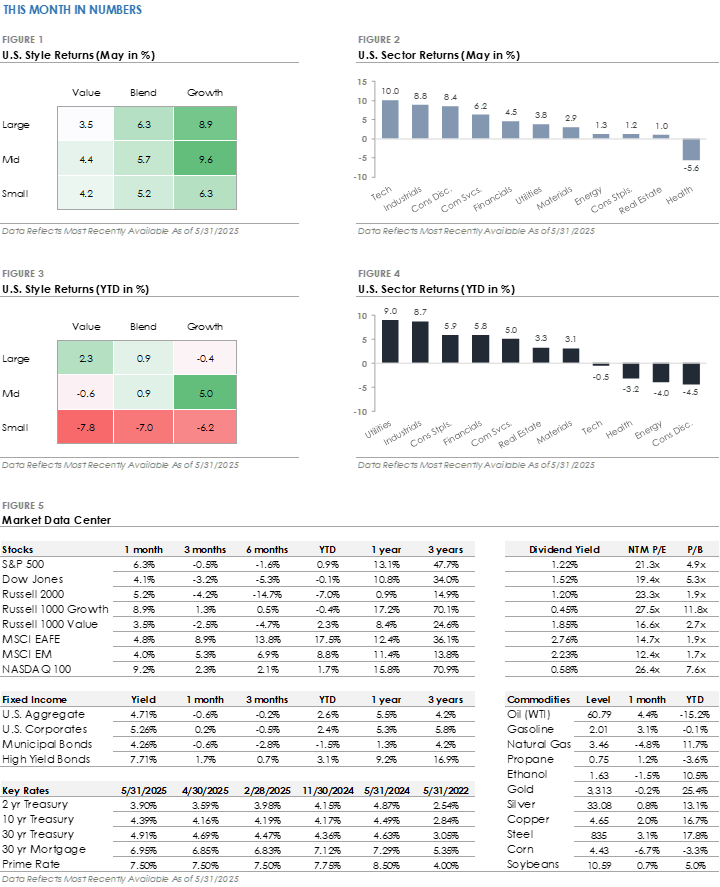Monthly Market Summary
The S&P 500 Index returned +6.3%, its strongest 1-month return since November 2023. Large Cap Growth stocks led the rally, with the Nasdaq 100 and Russell 1000 Growth gaining +9.2% and +8.9%, respectively.
Technology was the top-performing S&P 500 sector for a second consecutive month, with the Industrials and Consumer Discretionary sectors also gaining over +8%. Health Care was the only sector to trade lower, and defensive sectors were relative underperformers as the market traded higher.
Bonds ended the month with a slight loss, with the U.S. Bond Aggregate posting a
-0.6% total return. Corporate bonds outperformed as credit spreads tightened, with investment-grade posting a +0.2% total return and high-yield returning +1.7%.
International stocks traded higher but underperformed the S&P 500. Developed Markets gained +4.8%, while Emerging Markets returned +4.0%.
Markets Back Near All-Time Highs, But Forward Visibility Remains Low
The defining story of 2025 has been changing trade policy. Markets have weathered two months of policy-driven volatility, only to end up roughly where they started. After a nearly 20% decline from late February to early April, the S&P 500 has rebounded and is within 4% of its all-time high. What remains is weakened business and consumer confidence, rising inflation expectations, and a Federal Reserve that has paused interest rate cuts. The threat of a full-scale trade war and global supply chain disruption has diminished, but the full impact of recent events may take months to become known. Early economic data suggests the tariffs have had a limited impact, but we will continue monitoring what happens to economic and earnings growth in the coming quarters.
To date, the administration has introduced multiple 90-day tariff pauses. The pauses are temporary and staggered: the pause for most countries runs through early July, while the agreement with China extends through mid-August. A recent court ruling adds a layer of uncertainty by challenging the administration’s authority to impose tariffs, although the decision is under appeal. The U.S. economy entered the year with solid momentum, and current market conditions suggest investors are pricing in only a modest impact from tariffs. With policy details still emerging, markets are likely to remain sensitive to new developments, which could mean continued volatility over the coming months.
Looking Ahead: Navigating Uncertainty with a Steady Plan
What is most notable about this period is how quickly sentiment can change. Markets are forward-looking, which means they price in not only current conditions but also future expectations. This helps explain why the market can rally when data is weak and selloff despite strong earnings and economic growth. The stock market’s sharp decline and quick rebound is a reminder of the importance of maintaining a long-term perspective. Periods like this reinforce several important investment principles. Staying invested can help avoid the costly mistakes of poorly timed exits and re-entries. Emotional discipline and a well-diversified portfolio are your best defenses against making reactive decisions during market volatility. With the potential for more volatility, it’s important to focus on what you can control—diversification, discipline, and sticking to your long-term plan.


